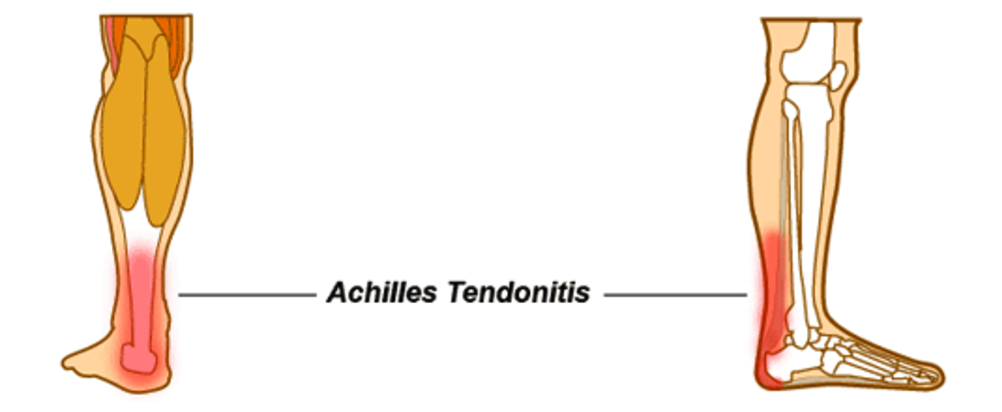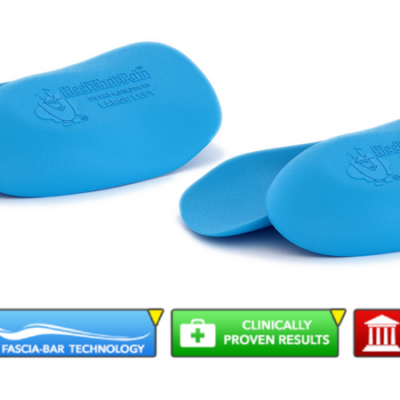Achilles Tendonitis
As the largest tendon in your body, the Achilles tendon is critical to walking, jumping, running, and every other form of exercise or physical activity that involves your legs or feet.
This important tendon was made to withstand a great deal of impact and stress; however, like any other part of your body, it can become damaged through overuse or injury.
Understanding the causes, symptoms, risk factors, and recommended treatments for Achilles tendonitis (or tendinitis) and Achilles rupture can help you get back on the path healing quickly, and before more damage to the Achilles tendon is sustained.

Causes and Diagnosis of Achilles Tendonitis
The Achilles tendon runs up the back of the ankle and connects the heel bone to the calf muscle. When this tendon becomes injured or inflamed, a painful condition known as Achilles tendonitis develops.
Achilles tendonitis can be chronic or acute. You may especially notice Achilles pain in the morning, after sitting, or while walking. If Achilles tendonitis is left unaddressed, the inflamed tendon can actually rupture (more on Achilles rupture below). The most common causes of Achilles tendonitis are overuse and damage, overpronation, and arthritis:
Overuse and Damage
Achilles tendonitis is commonly caused by overuse and damage. The condition can be brought on suddenly by a sports injury, or by intense physical activity without proper stretching or rest. Running without supportive footwear on hard surfaces is an especially common culprit of Achilles tendonitis.
Arthritis and Aging Tendons
Achilles tendonitis can also occur as a result of arthritis, especially among middle aged and elderly people. The aging process tends to result in a less flexible, weaker Achilles tendon and surrounding muscles and ligaments. This makes stretching and a proper warm-up an increasingly important part of any exercise or sports routine.
Overpronation
In a healthy stride, the foot pronates — or rolls inward — slightly. In an abnormal stride, the foot may overpronate, or roll inward too much. Overpronation puts a great deal of strain on the arch and the Achilles tendon. Over time, this strain can inflame and wear down the Achilles tendon.
Symptoms of Achilles Tendonitis
The most common symptom of Achilles tendonitis is pain at the back of the heel while walking or running. Other symptoms of Achilles tendonitis include the following:
- Bruising, redness, or swelling on the skin around the inflamed area.
- A sore Achilles tendon in the morning after first putting weight on your feet after waking up.
- Stiffness, or difficulty moving your foot or ankle.
- Pain that gets worse and is more noticeable when running, jumping, or during increased physical activity.
- Pain over the back of the heel, where the tendon connects with the heel bone (unlike pain from plantar fasciitis, which is localized
- where the plantar fascia connects to the heel bone on the underside of the foot, at the base of the arch and heel.)
- Pain that flares up after periods of inactivity. People often experience pain, soreness, or stiffness first thing in the morning, or may
- experience Achilles pain after sitting or lying down for extended periods of time.
- Over time, you may notice a soft, painful lump on the tendon.
To diagnose Achilles tendonitis, your doctor will do a physical exam of your foot. Your doctor may also do an MRI to rule out fractures and determine whether any tearing or other damage has taken place to the tendons in your foot.
Treatments for Achilles Tendonitis
In general, treatments for Achilles tendonitis focus on soothing symptoms and addressing the underlying cause that brought about the condition in the first place. Conservative treatments like NSAIDs, rest, icing, stretching, night splints, and orthotics are usually the most effective in alleviating the pain and healing the condition:
Anti-inflammatory Drugs
Anti-inflammatory drugs such as aspirin or Ibuprofen can reduce the swelling and redness caused by inflammation of the Achilles tendon.
Icing
Icing three times per day for twenty minutes at the site of the inflammation is another good way to reduce inflammation and promote healing for Achilles tendonitis.
Rest
Limiting stressful, sudden, or intense physical activity, such as prolonged running and jumping is an important factor in healing Achilles tendonitis, since the damaged tendon needs time to properly heal. When you do resume physical activity, do so gradually and pay close attention to your body’s signals to stop or rest.
Stretching
Special stretches that strengthen and improve flexibility in your Achilles tendon and the other muscles and ligaments of the foot can drastically improve healing time. When you do resume some physical activity, it’s extremely important to stretch properly to warm up the tendon before applying any strain.
Orthotics
Using an orthotic shoe insert is another conservative way to greatly reduce the symptoms associated with Achilles tendonitis. The orthotic insert helps to add corrective support to the heel of the foot, corrects overpronation, and helps restore the proper biomechanics to the heel and arch. In most cases this simple treatment is extremely effective in reducing irritation and strain on the tendon and alleviating Achilles tendonitis.
Night Splint
A traditional night splint or a Sock Night Splint can improve your Achilles tendon’s flexibility and promote healing even while you sleep, by keeping your heel and ankle flexed at just the right angle. A night splint can also reduce stiffness and morning pain that comes along with Achilles tendonitis.
Most of these same treatment methods can also be used to prevent Achilles tendonitis. Stretching, proper rest, orthotics, and icing are especially helpful to maintaining a strong, flexible, and healthy Achilles tendon.
Warning Signs and Treatments for Achilles Rupture
Achilles rupture can result from untreated Achilles Tendonitis, or a sudden and severe injury to the Achilles tendon. It’s important to know the difference between Achilles Tendonitis (inflammation and injury to the tendon) and rupture (a tear in the tendon), so that you can get the treatment you need quickly and avoid further damage:
Achilles rupture happens when the Achilles tendon suddenly tears, usually about two inches above the heel or ankle bone. People often describe hearing this tear as a “pop in my heel” a “snap or heel pop” and feeling as though someone has kicked them in the heel. This telltale popping or snapping sound is typically accompanied by the following symptoms:
- Severe pain, swelling, and stiffness
- Extreme difficulty in pointing the toes downward or standing on tiptoe
- Swelling and bruising between the calf and heel
- A noticeable gap or depression about two inches above the heel bone
Achilles tendon rupture is very common in “weekend warriors”, during high-intensity bouts of exercise or physical activity. Rupture is also common during recreational sports that require short bursts of jumping, running or pivoting, such as basketball, racquetball, tennis or badminton. The rupture often happens while making a forceful push-off while the knee is straightened or a sudden trip or fall with the foot receiving much of the force.
The aging process can also increase your risk of Achilles rupture. As we age, the tissues and tendons in our body become more inflexible. And the leading cause of Achilles tendonitis and Achilles tendon rupture is a lack of flexibility!
Treatment for Achilles Rupture
Prompt treatment is required for Achilles tendon rupture, to restore normal length and tension to the tendon.
Depending on your situation and the extent of your injury, treatment for a rupture can be solved with surgical or non-surgical treatments. Both types of treatment require an initial period of wearing a cast or special brace. This period usually lasts about 6 weeks; followed by a change in casting at 2 to 4 week intervals to slowly stretch the tendon back to its normal length. In cases where surgery is required, your doctor will reattach the tendon, followed by casting.
Support
At Heel That Pain, we’re here to help you find answers to the questions you have and get you back on your feet–without pain. If you’re currently experiencing heel or arch pain, you may find the following free resources helpful as well:
Free exercises to try before you buy any treatment for foot pain
Helpful videos and home remedies for Plantar Fasciitis and tendonitis






